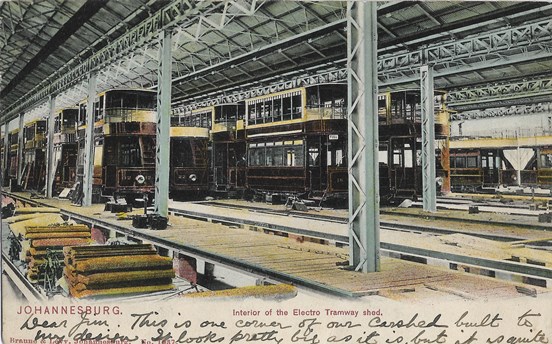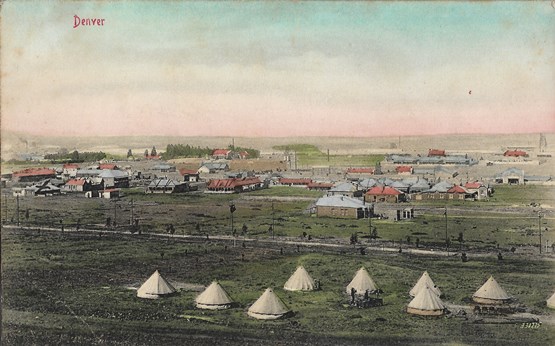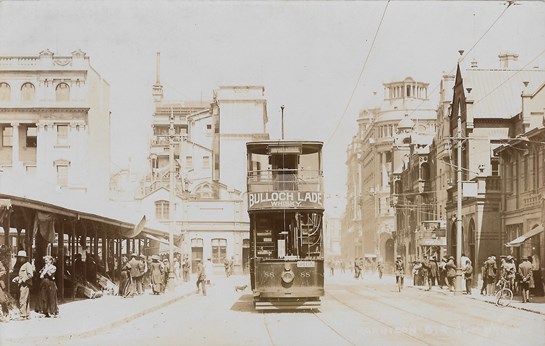TRANSVAAL PICTURE POSTCARD MESSAGES
JOHANNESBURG TRAMS
Introduction
Most people lived within walking distance of their place of employment. However, the first east-to-west horse-drawn trams, were first introduced in Johannesburg during 1891, and ran between Jeppe and Fordsburg. (i.e.Jeppestown through vacant ground called the City and Suburban, to Commissioner Street, Johannesburg and through to Fordsburg.) They were popular from the first day, and it is thought that, clerks could get home from lunch and back for the first time, although no one seems to have recorded where the tram drivers obtained their lunch! (However, cooked food could be purchased from stalls around the walls in Market Building and perhaps from other street food venders.) Before then the only way to get home for lunch was by Cape carts, at a minimum fare of two shillings from Johannesburg to Jeppe or Fordsburg. The first motor car reached Johannesburg in 1894 and the motor bus, circa 1905, when the Consolidated Investment Company imported them, to run from Johannesburg to Yeoville. Thus they were able to sell their stands (plots of land) in Berea, Bellevue and Yeoville. However, the motor bus was not a success, as the roads were very rough. The horse-drawn trams were superseded by electric from 1906, following the completion of the Power Plant that year. By 1914, there were 65 miles of track with a tramways gauge of 4ft.8½inches.
Interior of the Electro Tramway shed

The Postcard
Published by Braune & Lévy, Johannesburg, as card number 1?37 and captioned in red, ‘Interior of the Electro Tramway shed.’. The divided back (address side) is also printed in red.
The Message
The manuscript date is: "Sept 23rd 06
Dear Jim, This is one corner of our Carshed built to my design. It looks pretty big as it is, but it is quite three times bigger than this. There are 15 tracks and it holds over 100 cars besides having a Stores, Painting Shops, Workshops, Armature Shops & Controller Shop under the one roof. It is over 300 feet long and over 200 feet wide. Six bays. Five of 33’-6” and one of 40’-0”. It has cost £25,000 odd to erect. All the routes are now in full swing. Over 50 miles of route, and 80 cars in continual service. We are ordering more cars. The takings average 2/8[d.] for every car mile, plus advertisements."
Denver new tram line

The picture postcard
Captioned 'Denver' in red on the picture side and published by 'Sallo Epstein & Co , Durban' which is printed, in green, on the divided back (address side). This card is also numbered '2388'.In the space for the stamp is printed 'STAMP / Phototyped in Dresden'.
The message
"I have put a x on the top of these three houses. You will see our windows set out at the end house & the little garden in front. the white at the back is the yard. These tents are for the Kafirs, when they were making the tram line. that white road is the tram line but they are not running yet"
Note
Denver is to the east of Johannesburg,

The Postcard
Printed in black on the divided back address side is the name of the publisher,' “SAPSCO” ' (South African Photo & Stereo Company) 'Real photo. Box 5792, Johannesburg.'.
The message
"We have some decent sized buildings in Jo.burg but what spoils them are the little tin shanties next to them. The low roofed place on the left is the fruit market, the crowd that assemble there is one of the most cosmopolitan in existence …"
Note
According to C. Board (1967):
‘The time that Johannesburg was being planned, land cost too much to ‘waste’ on roads and plots are often smaller, creating the right conditions for the future vertical growth of shops and offices.’
Therefore, the ‘little tin shanties’ were soon to grow into cliffs-like faces. Nevertheless, there seems to have been no control over the height of one building to the next, so the skyline was still a jagged mess.
Perhaps the Fruit Market was built after the Johannesburg, Market Building, plague of 1904. If so winter was not the place to stand out in the cold and it is said that many moved back to their own shops.
The stationary tram in Harrison Street, is numbered 88, but this may not have been on its usual route as there is a board on the cab which informs the public it is a 'SPECIAL'. The destination at the top of the tram reads 'Market Square', so it had already arrived. As trams have a cab at both ends, I'm not sure which way this tram is going! But as it is on the left line, we are probably looking at the rear for this journey. Note the dog to the left.
The advertisement on the tram is for Bulloch Lade Whisky. Bulloch Lade & Company was a successful business and owned distilleries which included Loch Katrine and Caol Ila. They closed before the Great War of 1914. However, the name continued with another company, and they received a Royal Warrant from King George VI which lasted into the 1950s.
Perhaps insolvency was just a matter of spending too much advertising on trams! Advertising on trams was obviously important for the tram company, as shown in the message of the first postcard on this page.
Reference
Yearbook of the Union of South Africa 1910-1918, p.772.
Board, C., (1967), 'Southern Africa' in, Hodder, B.W., and Harris, D.R., Africa in Transition, Geographical Essays, London, pp.345-346.
Cripps, Elizabeth Ann, (2012) Provisioning Johannesburg, 1886-1906, submitted, Master of Arts in History at the University of South Africa, p.103.
- - Johannesburg, Market Square - -
Most recent update 27th April 2021
Copyright © J Woolgar 2020 & 2021
- - o - -